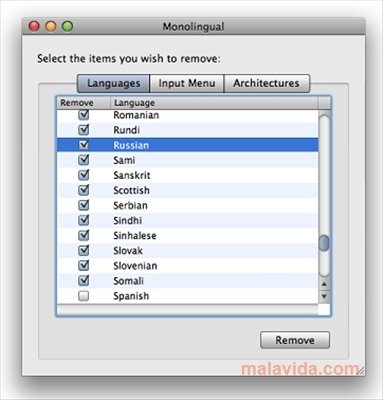Update : 2013
Don’t use Monolingual if you have Mountain Lion or later.
Apple made significant changes to reduce the footprint so languages etc are no longer installed. The old CPU types no longer used.
Download the Sonos app for iOS, Android, FireOS, Windows, and macOS. Monolingual is a program for removing unnecesary language resources from OS X, in order toread more → Mactracker for Mac Mactracker provides detailed information on every Apple Macintosh computer ever made, including items such as read more →. Monolingual for Mac, free and safe download. Monolingual latest version: Eliminate unnecessary language localizations from OS X.
I use Monolingual to save space on the MAC OSX. Quick word on how much space you can save and how to do it.
At time of writing, Monolingual has been updated to Version 1.4.1 and I took the step to run it on my Snow Leopard. Even after my cat cancelled the Removal, I think it saved more than a gigabyte of space. As you can see below, the screen shows 320M and the program had been running for longer.
and removing unwanted architectures got me another 299M.
Edit: I got a new MacBook recently and ran MonoLingual after a a full install and I saved 2.3Gigabytes of space.
So I will be continuing to use Monolingual to keep my Mac as lean as possible. All the configuration and setup remains identical and the original article continues below.
The first time I used Monolingual on Leopard I got more than 3GB back. I ran Monolingual yesterday and got 500 MB back after it deleted all the language files from various programs that had been updated or installed in recent weeks.
Today, I installed the 10.5.3 update (420 MB), then rang Monolingual to remove all the Language packs and got 240MB. Removing the PowerPC Architectures got me another 20MB for a total saving of 260MB.
If you haven’t used Monolingual, it is freely available http://monolingual.sourceforge.net/. Think carefully before removing architectures – if you have ANY legacy software, it can break your computer. Removing languages is very simple, low risk and you get a lot of space back.
Slimming down the languages
OS X, and every program contains language files for every language that is supported – typically more than one hundred languages. This is a lot of redundant information.
Here is how languages screen looks, I keep the US English as some people have indicated that certain developers don’t honour the API’s and can break their applications if US English is not there. Everything else can be safely deleted. You MUST keep English (or you will be restoring from a backup).
Input Menu
The Input Menu doesn’t save much space (less a megabyte):

Monolingual Mac Download Crack
Architectures
The Architectures doesn’t save a lot of space so many people don’t touch this – if you are risk averse then just skip this section. I am short on disk space, so getting 500MB back is worth it. As I understand it, this goes through all the programs on your drive and removes any of the code that makes it compatible with PowerPC systems (or something like that).

WARNING:
1) Have a backup before you do this.
2) Know how to restore OS X BEFORE you start.

3) Make sure you are running an Intel based Mac (because that is what these instructions are about).
4) Did you double check you are running an Intel Based MAC check here to see what you should see.
This is how my preferences screen looks. The latest versions of Monolingual are correctly configured to stop problems that happened in earlier versions.
Final Thoughts
Imac Sleep Settings
Every time a program downloads an update, the language files are reinstalled. OS X updates also add the language files back (in some parts at least). So you should run Monolingual on regular basis, say every month or so.